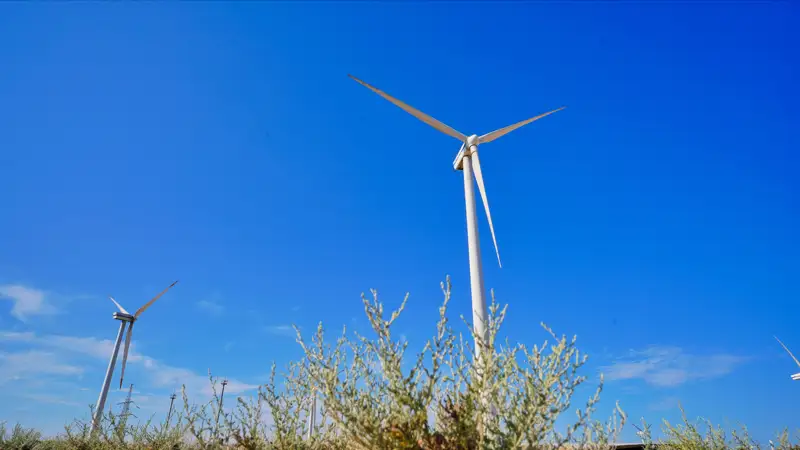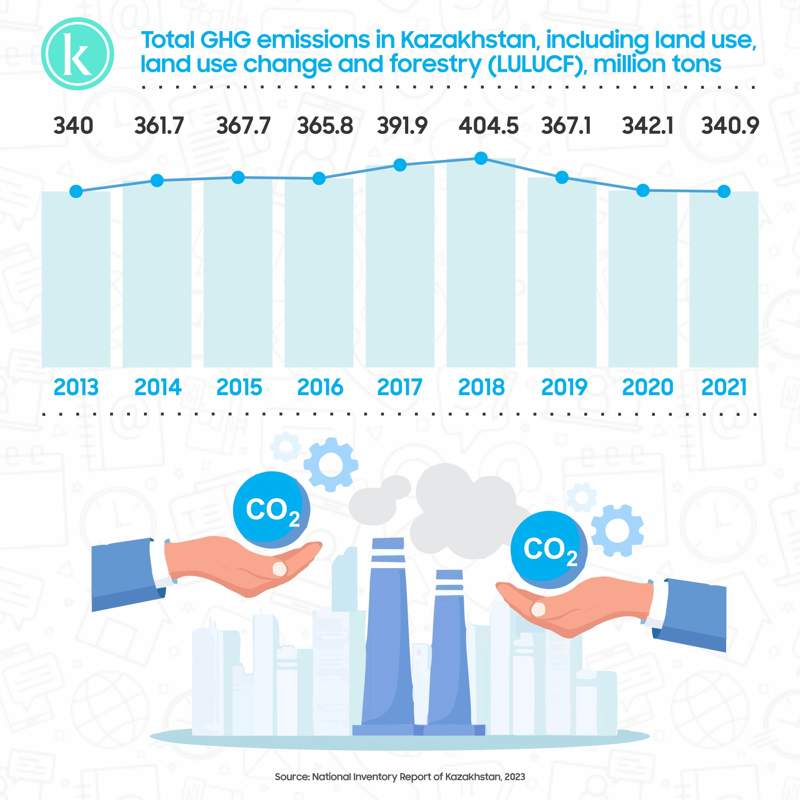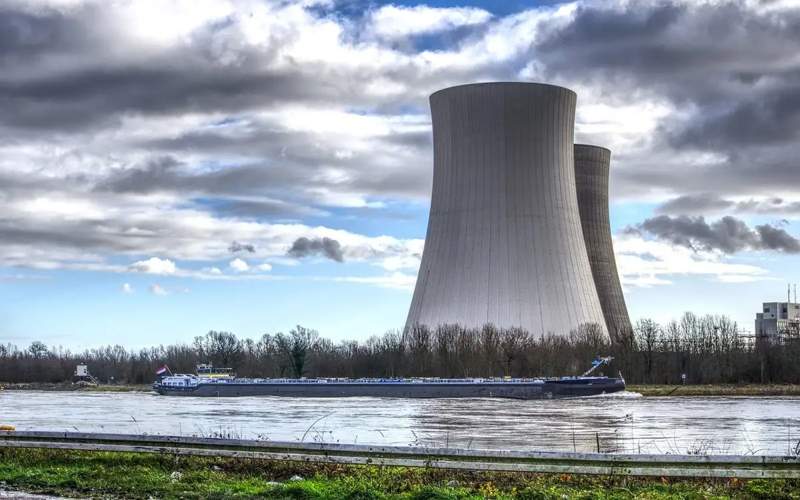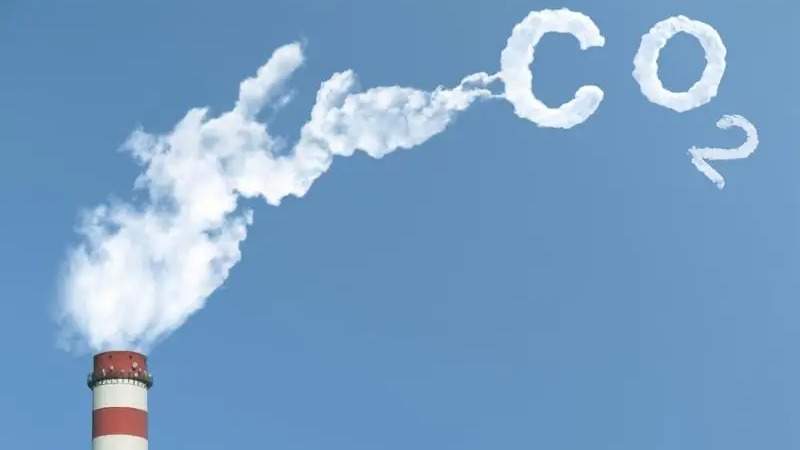One year later: unveiling progress of Kazakhstan's carbon neutrality strategy
One year has passed since Kazakhstan adopted its ambitious Carbon Neutrality Strategy, marking a commitment to addressing climate change and reducing greenhouse gas emissions (GHG). In this analytical piece of Kazinform News Agency, we aim to assess the progress made, the challenges encountered, and the overall impact of the strategy on Kazakhstan's journey towards a more sustainable future.

What is the strategy about?
The strategy was adopted on February 2, 2023. It was developed considering global climate trends, such as the implementation of transboundary carbon regulation mechanisms, environmental, social, and corporate governance (ESG) principles, promotion and attraction of green investments, energy-efficient production, and electrification. The overarching goal of becoming carbon neutral by 2060 is the commitment that President Tokayev announced at the Climate Ambitions Summit in December 2020.
Objectives of the strategy
The strategy outlines a series of essential measures aimed at reducing emissions and achieving decarbonization in the economy.
The mid-term objective of the strategy is an unconditional reduction of GHGs by 15 percent by 2030 compared to the emission levels of 1990.
Low-carbon development envisioned for 2060 entails incremental substitution of coal with alternative and renewable energy sources, phasing out the combustion of fossil fuels and transitioning to the use of hydrogen, biofuels, and synthetic low-carbon fuels in processes that are difficult or impossible to electrify, and adoption of carbon capture and storage technologies.
Additionally, it proposes initiatives such as a tree-planting program targeting 2 billion trees by 2025, a twofold increase in the proportion of renewable energy sources in electricity generation by 2030, complete sorting of municipal solid waste by 2040, the promotion of sustainable agriculture covering 75 percent of arable land by 2045, and achieving 100 percent electrification of personal passenger transport by 2045.
Many of these initiatives stem from Kazakhstan’s obligations under the Paris Agreement, which it signed on August 2, 2016, and ratified on December 6, 2016. Before that, Kazakhstan joined the United Nations Framework Convention on Climate Change (UNFCCC) in 1995 and ratified the Kyoto Protocol in 2009.
Under the Paris Agreement, Kazakhstan pledged to reduce its GHG emissions to 15 percent below 1990 levels by 2030, including land use, land-use change, and forestry (LULUCF) as an unconditional target.
The conditional target, which means if international means of support are provided, is the reduction of GHG emissions by 25 percent by the end of 2030 relative to the 1990 base year. However, this depends on substantial international investments and grant assistance, and access to an international technology transfer.
Greenhouse gas emissions
Human-induced GHG emissions have surged to unprecedented levels in recent years. Widespread and catastrophic effects of climate change continue to be seen globally.
Kazakhstan is one of the largest emitters in Central Asia.
According to the National Inventory Report submitted by Kazakhstan to the United Nations Framework Convention on Climate Change (UNFCCC) in 2023, the total national GHG emissions, including the land use, land use change, and forestry sector, decreased by 10.35 percent from 1990 to 2021. In the year 2021, there was a 0.37 percent reduction compared to 2020.
To reduce emissions by 15 percent compared to the 1990 level, Kazakhstan's emissions balance should not exceed 328 million tons of CO2-equivalents by the year 2030.

Based on this data, nearly 80 percent of the country’s total GHG emissions in 2021 were attributed to the energy sector. The report indicates total GHG emissions in the energy sector amounted to 261.9 million tons of CO2 equivalent. This is 17.2 percent lower than the 1990 level and 0.9 percent higher than the emissions in 2020 (259.5 million tons).
The primary source of GHG emissions in the energy sector is energy industries, which encompass the production of heat and electric power, oil refining, and the production of oil, gas, and solid fuels.
Annually, approximately half of all GHG emissions in the energy sector are attributed to the production of heat and electric power. However, worn-out systems for both electricity and heat distribution contribute to high energy losses of up to 35 percent of total electricity losses in certain regions. This is one of the factors that increase GHG emissions from the sector.
The strategy indicates that in the structure of national GHG emissions, carbon dioxide (CO2) constitutes 81.6 percent, primarily released through the combustion of fuels and in agricultural practices involving plowing.
Methane (CH4) contributes 12.4 percent to the emissions. Methane is mainly emitted in processes such as fuel extraction, transportation, handling/storage, biodegradation of organic waste, and animal husbandry for meat, milk, wool, and leather production. Nitrous oxide (N2O) makes up 5.6 percent of the emissions.
According to the International Energy Agency, the CO2 intensity of Kazakhstan's GDP is approximately 70 percent higher than the global average. This comes from the country's economic structure, characterized by energy-intensive heavy industries and a significant reliance on coal for electricity generation.

“For an economy of its size, Kazakhstan leaves a disproportionately large ecological footprint in the form of greenhouse gas emissions. The country ranks 20th in the world regarding emissions per capita,” writes the World Bank in its November 2022 report.
Policies
The strategy envisions the digitalization of monitoring of the composition and volume of GHG emissions, including the development of a targeted program for monitoring satellite data to control emissions at the national, sectoral, and regional levels.
Utilizing satellite remote sensing for monitoring emissions will provide transparency, objectivity, and comparability of data, enabling participation in international economic mechanisms in accordance with the Paris Agreement.
The most significant reduction in GHG emissions in the energy sector will be achieved by shifting towards more sustainable energy sources. This involves gradually decreasing the use of fossil fuels and transitioning to the use of electricity and heat instead of directly burning fossil fuels.
There will be a phased and systematic reduction in the share of coal generation, coupled with an increase in the share of renewable energy sources and alternative energy. In 2020, Kazakhstan already surpassed its target of 3 percent - the share of energy generated by renewable energy in the total energy balance.
Kazakhstan seeks to achieve ambitious targets to bring the share of renewable energy to 15 percent by 2030 and 50 percent by 2050. As of 9 months of 2023, the share stood at 5.97 percent, according to the Ministry of Energy.
The Environmental Code, whose new edition was adopted in 2021, establishes a robust legal framework for rational natural resource management, including the requirement to adhere to the ‘polluter pays’ principle, meaning that businesses are obligated to take responsibility for past and future environmental damage.
The code defines the architecture of the GHG emissions trading system (ETS) in Kazakhstan. It mandates the adoption of the best available technologies for managing GHG emissions in the implementation of new major investments.
GHG from large enterprises
Reporting at the government meeting on January 23, Minister of Ecology and Natural Resources, Erlan Nysanbayev said that there has been a reduction in emission limits for some major industrial enterprises, with examples such as a 34 percent reduction for the North Caspian Operating Company (NCOC), 16 percent for ArcelorMittal Temirtau, 22 percent for Astana Energy, and 18 percent for Kazakhmys Smelting.
He noted in 2023, 652 inspections were conducted, revealing 1,679 violations and 628 prescriptions were issued for their elimination. The operations of 31 enterprises were suspended through legal proceedings.
Under the Environmental Code, in the next 5 years, experts will conduct a comprehensive audit of major pollutant enterprises, resulting in concrete proposals for introducing the best available technologies and reducing emissions.
According to Kazakh ecologist Laura Malikova, starting from 2025, the 50 largest enterprises are obligated to replace their old technologies with the best available technologies (BATs) by 2025.
“Failure to do so will result in a two-fold increase in tax rates initially, and then a four to eight-fold increase. Additionally, irregular fines are imposed for unauthorized operations and failure to carry out land reclamation, calculated based on income. The Ministry of Ecology should monitor compliance with these norms and mechanisms,” Malikova said in a comment for this article.
Nysanbayev, in turn, stressed to control industrial emissions from the largest enterprises, efforts are underway to establish an automated monitoring system (AMS).
“The implementation of AMS will allow us to monitor the impact of natural resource users on the environment in real-time and respond promptly, both in terms of preventive measures by the enterprise and actions by state control,” added Nysanbayev.
One year since the adoption of the strategy
One year into the adoption of the strategy, the tasks are not being “adequately fulfilled,” said Laura Malikova.
“Yes, the strategy has been adopted in Kazakhstan. In various sectors of the economy, it is necessary to minimize the use of coal and gas while increasing the number of trees, preserving greenery, and emphasizing natural solutions. Currently, this task is not being adequately fulfilled,” she said.
Coal is still being used in many cities where industrial production is the key sector. These cities include Ust-Kamenogorsk, Semei, Petropavlovsk, and Ekibastuz. Air quality is extremely poor in these cities.
“Overall, about 70 percent of the country's energy comes from coal. Therefore, substantial work is needed in this direction. Gas should become the primary source of energy in our power generation within the next 10-15 years. Therefore, there is a need to start using gas to the maximum extent on the domestic market,” stated Malikova.
She mentioned the gasification process in the country, which began in Astana in 2017.
“Since 2018, the Saryarka gas pipeline has been constructed, connecting the cities of Temirtau, Zhezkazgan, Karaganda, and Astana. As for Almaty, a technical project for transitioning from coal to gas has been developed, but implementation takes years,” she said.
She also does not observe measures taken for forest and greenery planting, river and lake protection, fire prevention, and carbon-rich area preservation. “Thus, insufficient progress has been made,” she concludes, while optimistic that achieving carbon neutrality by 2060 is possible.
Nuclear energy
Nuclear plants as a source of alternative energy do indeed align with the carbon neutrality strategy and with the country’s commitments under the Paris Agreement, she noted.
The strategy itself notes that “nuclear power plants will be integrated into the power structure as a stable energy source, necessitating the formulation of a long-term vision for the development of nuclear energy.” However, according to Malikova, there are fundamental issues that need to be addressed.

“However, radioactive waste poses a serious problem in nuclear power plant construction. Moreover, in case of an accident, the consequences would be more severe compared to conventional power plants. Therefore, this project could be effective in terms of air pollution, but first, corruption needs to be addressed throughout Kazakhstan,” she said.
Economic costs
Kazakhstan can no longer afford to delay its green transition. The economic costs of this delay are substantial.
One example is the Carbon Border Adjustment Mechanism (CBAM), which the EU will kick off in 2026. This mechanism will impose an import levy starting from 2026, which will depend on the carbon intensity of the products. Considering that the EU is the key trade partner for Kazakhstan, modeling results indicate that Kazakhstan could lose over $250 million in annual export revenue to the EU due to the introduction of CBAM, according to the World Bank Country Climate and Development Report released in November 2022.
“The black metallurgy sector is at the greatest risk, and if the scope of CBAM expands, losses could increase to $1.5 billion. These losses could be reduced if Kazakhstan takes measures to reduce the carbon intensity of its exports, especially by implementing a carbon pricing mechanism. Such a pricing mechanism may be recognized by the EU, and the corresponding producers could be exempted from paying the CBAM levy,” wrote experts in the report.
All comes to financing
While the measures outlined in the strategy sound good on paper, ultimately everything comes to financing.
The carbon neutrality strategy indicates clean investments (financial decisions supporting environmentally friendly and sustainable projects or companies) in low-carbon technologies, contributing to low-carbon development and achieving carbon neutrality, are estimated at $610 billion, accounting for 19.6 percent of the gross accumulation of fixed capital.
Direct government investments in achieving carbon neutrality will constitute just 3.8 percent of the total investment volume.
“More than half of the required investments, or $386.3 billion, are existing and circulating investments within the economy that will be redirected from raw material sectors to more green sectors of the economy. The remaining portion, amounting to $223.7 billion, represents new investment resources,” reads the document.
The investment requirement until 2030 is $10 billion, with the remaining $600 billion to be invested by the end of 2060.
Need to involve private sector
Experts emphasize the green transition depends on proper financing, requiring the combination of the public and private sectors. Engaging the private sector is of paramount importance.
However, World Bank experts note that the current impediment to the green transition in Kazakhstan lies in the prevailing dominance of state enterprises and high levels of regulation, hindering the development of private entrepreneurship.
With that, the private sector lacks incentives to drive innovative and environmentally sustainable initiatives.
Compared to other countries in Central Asia, private sector enterprises in Kazakhstan are less prepared to adopt green practices and invest in the development of eco-friendly solutions. According to the World Bank, only 18.5 percent of Kazakhstan’s enterprises have established targets for energy consumption and CO2 emissions.

Overall, decarbonization is not only about reducing GHG emissions, installing new renewable energy capacities, and attracting investment. It requires a holistic approach involving everyone - the government, businesses, and society in general. Change in the mindset is also needed to create a more informed society about the green agenda and the impact of climate change.
Once efforts are truly underway, the positive impact becomes undeniable, making the Kazakh economy more resilient and sustainable.
